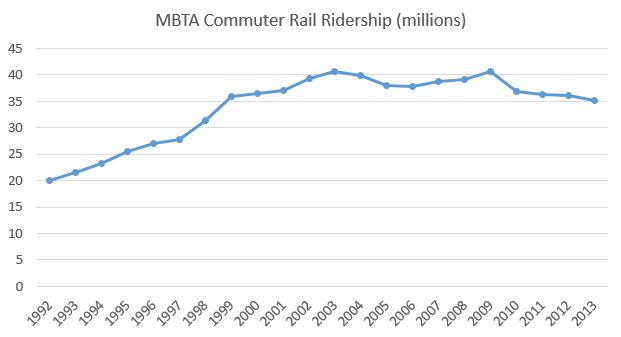MBTA Commuter Rail Only System in Country in Decline Over the Last Decade
Earlier this month, Pioneer Institute reported on the MBTA commuter rail’s problem with timeliness. After further research, however, it is clear that this finding barely taps the surface of the long-brewing problems that the unpopular agency now faces.
Thousands rely on the MBTA every day, and yet commuters continue to face commutes characterized by long, uninformed waits and frigid temperatures. The natural question is, what went wrong?
Statistics from the National Transit Database (NTD) show that the MBTA is the sixth largest commuter rail system in the country in terms of annual ridership, serving just over 35 million passengers in 2013. Unfortunately, ridership has been declining since its peak of 40 million passenger trips in 2003, bucking the national trend of growing ridership and despite the fact that the T’s service area population is growing and commuter rail lines expanded.
Taken by itself this is not a truly troubling observation, but the MBTA is the only commuter rail system in the country that lost passengers over this time period. The average system increased its annual passenger trips by an average of 63 percent, while the MBTA’s total fell by over 13 percent.
Between 2003 and 2013 the MBTA’s average fare more than doubled, growing by almost 130 percent. Besides Dallas Area Rapid Transit (DART), no other commuter rail system increased their rates as much.
Additionally, the ratio of fare price to vehicle mile travelled more than doubled, bringing the system up from well below average levels. In 2003 the average passenger paid approximately $0.11 per mile traveled, while in 2013 that number had risen to $0.23 (compared to a national average of $0.19).
Public transportation systems are often heavily subsidized; they are seen as a valuable public good that facilitates economic activity and growth, as well as allowing an active and alluring metropolitan area to expand its reach. Currently the MBTA subsidizes every commuter rail trip by $10.50. Considering that the average passenger in 2013 paid $4.80 per trip, the MBTA had to raise fares to bring its fare-box recovery rates up to viable levels.
Over the same time period the MBTA’s commuter rail system also added $153 million to its operating costs, totaling $351 million in 2013. So not only is the MBTA’s commuter rail the only to lose passengers in the last ten years, it’s also the system that has increased its fares and operating costs more than any other comparably sized commuter rail system.
This downward trend in ridership accompanied by the increase in fares is a troubling sign for the already embattled MBTA. Research shows that commuter rail ridership, especially in the long term, can be sensitive to changes in price. Many commuters who elect to take a train park their cars at a station, but could choose to drive the rest of the commute if the train is seen as a more costly or less pleasant option.
The MBTA’s fare increases finally brought it in line with other commuter rail systems in terms of fares. However, the damage is done as the past’s low fares could have been supporting an artificially high ridership level.
The question then becomes, what should the MBTA do now? Raising fares any further risks alienating its remaining commuters, so operating costs must be controlled instead. The right place to start is to stop new expansions until the agency has a better handle on its existing infrastructure.
The MBTA is already mired in over $5 billion of debt, due in part to Big Dig mitigation projects and other expansions. The Greenbush line was opened in 2007, Rhode Island service was expanded in 2010 and again in 2012 and stations are under construction to expand service on the Fairmount line among other projects. Despite near constant expansions in the last decade the ridership levels have still been falling.
Keolis, the commuter rail’s new French operator, believes that it can turn the system around by drawing on its wealth of commuting experience. The new contract could last as long as 12 years and save the state $254 million. But Keolis has its work cut out as they inherit a troubled system and face a suspicious and fatigued ridership.
The lack of preparedness for this brutal winter combined with a decade of minimal investment in maintenance have exposed the weaknesses of the MBTA’s commuter rail system. With a new operator, viable fares and a more responsible approach to expansion projects, there’s a ray of hope that the MBTA can weather this winter of storms.





